Float Fishing For Trout: 8 Tips Expert Guides Use
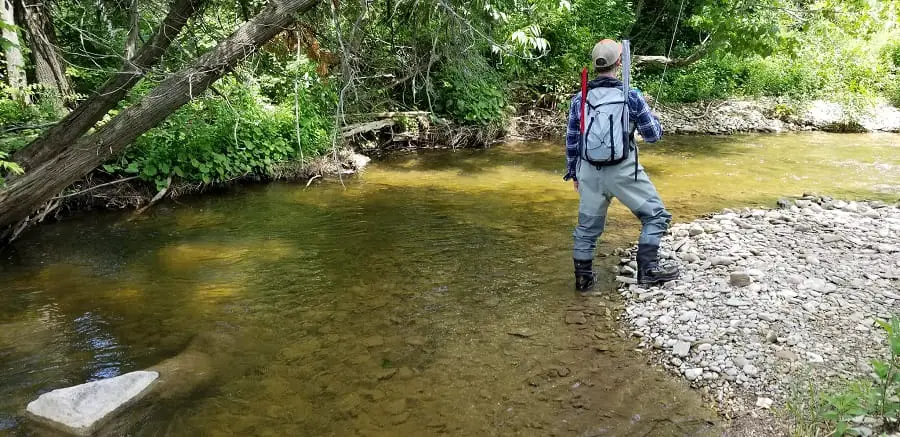
I have been float fishing for trout for over 37 years, and as one of the top trout guides, I have learned some really important things that all anglers should do. I’m going to share my tips and the five key fundamentals that, if all done well, will significantly increase the amount of trout you will catch when float fishing.
These are the things I teach all my clients.
In case you are new: Float fishing is an effective method of presenting a bait below a float to catch trout in rivers. It is most effective in spots that are three feet deep to 15 feet deep. It can also be done on lakes and ponds.
5 Fundamentals Of Good Float Fishing For Trout
There are five fundamentals to good float fishing techniques for trout. If you can master these, you will catch a lot more trout.
- Control your speed – This means controlling the speed of your bait once it’s in the strike zone, which triggers more bites.
- Find the bottom – Determine how deep your bait is so you can keep your bait in the strike zone which will ensure you catch more trout.
- Cover the water effectively – Effectively covering the water through the entire spot, as well as from surface to bottom will mean more trout landed.
- Use the right float fishing setup – Your setup and gear enable you to present your bait more effectively, which results in more trout in the net.
- Use the right baits – Using high percentage baits and rotating through baits to determine what the trout wants will significantly increase your catch rate.
There are some other things that I do as a guide to ensure that my clients catch the maximum amount of trout. Some of these things are so effective that if done well, you could catch ten times more trout.
I will also discuss:
- The best floats
- My proven leader setups
- Types of rivers for float fishing
- How to significantly increase how many trout you catch
- Rods, reels, and lines
1. Control Your Speed: The Number 1 Fundamental Of Float Fishing
In my opinion, one of the most important aspects of presenting your bait is speed control. In fact, speed trumps even a good bait. Even though trout can swim fast, they don’t want their food moving faster than the current.
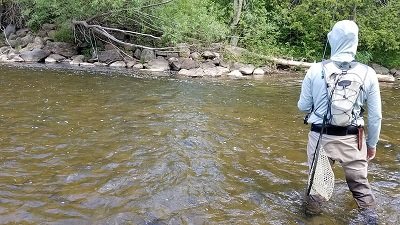
The reason I say this is because after guiding thousands of anglers, I have seen what happens when clients do not control the bait speed (no fish) compared to anglers who do control their bait speed well (lots of fish).
When I float fish for trout in a river, I carefully control the speed of my bait. Speed control is why one guy catches ten trout, and the other guy catches none. It’s rarely the bait!
Using the right float is extremely important to control your speed, and only certain float work well!
To control your speed effectively, you need to understand leader and float angles, and you need to know how to hold your float back (some call it trotting or checking the float), and you need to do it properly and all the time.
For more in-depth details on why and how to do this effectively, see my page on Controlling Your Speed When Float Fishing.
2. Find The Bottom
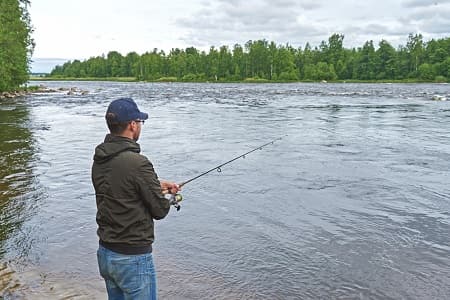
I tell all my clients the first thing they should do in every new spot is to find the bottom because that is where the trout usually are, and that is where they will feed.
The closer your bait is to those trout, the more likely they are to bite it.
When float fishing, you set the depth of the float and then cast and see how the float or the fish react to that setting
The depth of your float should be about the same length as the depth of the spot you are fishing. That’s easy to do if you can see the bottom and if you know exactly how deep the spot is.
What if you can’t see how deep it is?
I set my float and make a drift, and if I start hitting bottom, I will shorten up the leader, and if I don’t hit the bottom, I will make the leader twelve inches deeper. A good river float will help you detect the bottom and do this right.
The mistake most guys make is that when they finally detect the bottom, they fish the whole spot with that length of leader. Unfortunately, many spots won’t be the same depth all the way through the spot, and often, the trout will sit in deep holes and trenches.
You need to find the bottom to find the fish. The further your bait is from the trout, the less likely they are to bite it.
See How To Know How Deep To Set Your Float.
3. Cover The Water Effectively
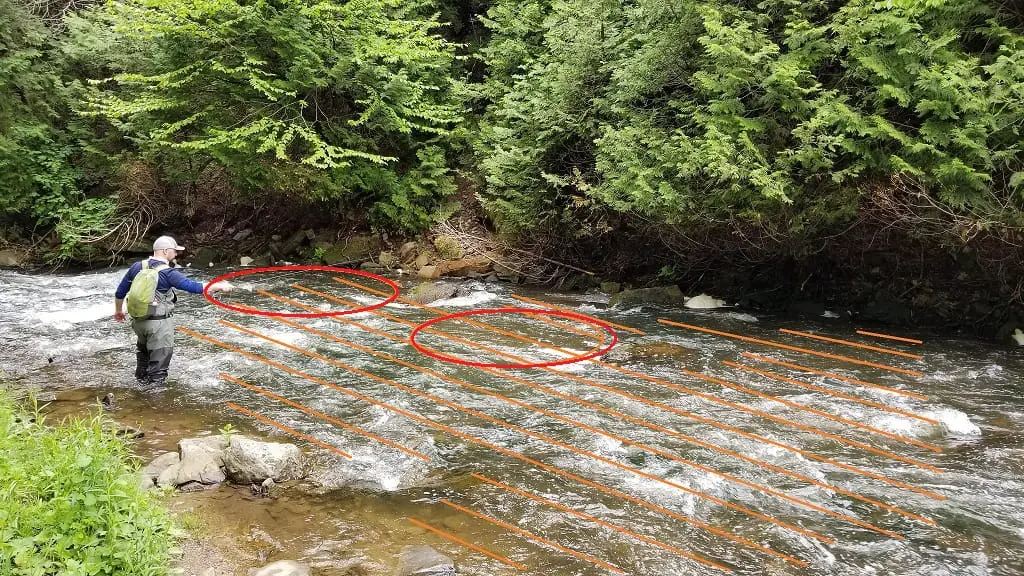
I use a very systematic approach to cover the water. I believe, based on 35 years of experience fishing for trout, that trout can be anywhere in the river and are often where you least expect.
Therefore, if I’m going to fish a spot, I’m going to fish all of it, and not just that nice seam, or that deep pocket, or the most obvious spot that everyone else fishes.
The picture above shows the obvious spots that are circled in red.
Most anglers will fish these spots and move on, but the lines indicate where I would fish, and as you can see with the lines, I would run my bait through almost every foot or two of water on a spot like this, and it often pays off with big trout from unsuspected places.
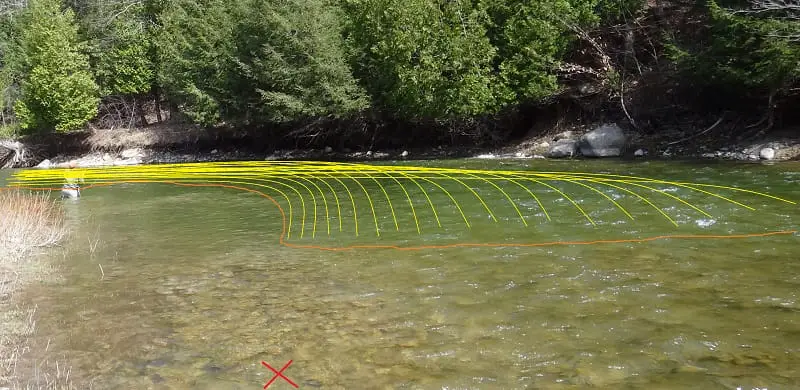
Many of the biggest trout that my clients and I catch are in water less than 2 feet deep, even if there is water closer by that is 4 to 6 feet or deeper.
Why is that? Well, that’s a whole other story, but for now, let me just say, start fishing everywhere in a systematic way, and you will catch more large trout.
4. The Float Fishing Leader Setup
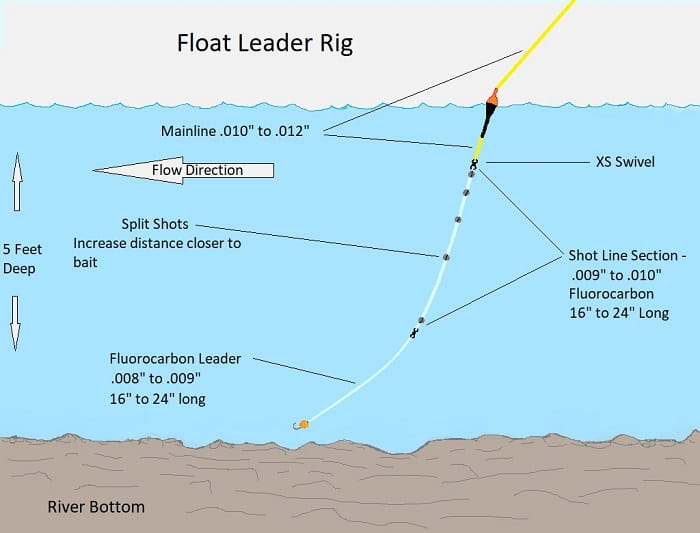
The leader setup is a critical part of float fishing that can not be done poorly if you want to maximize the amount of trout you catch.
I set my float fishing leader up a certain way to be able to get the best presentation, but also to aid in speed control and depth detection.
This top picture is my go-to float rig that I use for big trout in most rivers..
The above illustration is my go-to trout float leader setup in water from 3 feet to 8 feet deep. Below is what I would use when fishing less than 3 feet.
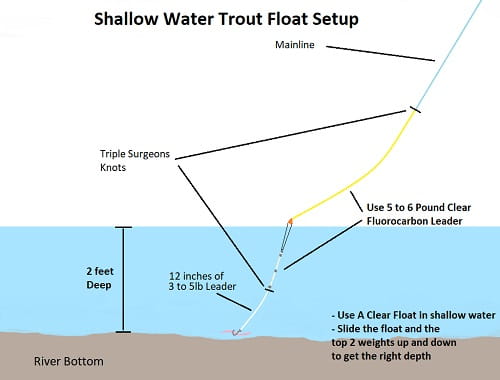
When Float fishing for smaller trout, I adjust the line sizes to river conditions like speed and clarity and for the size of the trout.
In really clear water; I use a 3-pound leader on the bottom and a 6-pound leader on the shot line.
Check out my page 2 Float Fishing Leader Setups From A Pro River Guide.
Presentation is the key to catching more trout, and the leader you use ensures your presentation is the best it can be.
5. The Best Baits To Use Under A Float For Trout
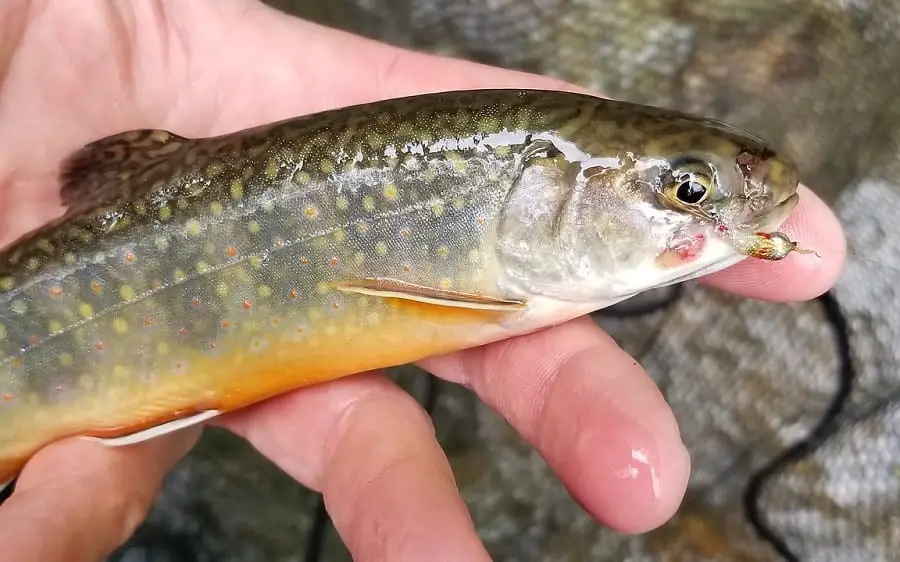
The fifth fundamental to good float fishing is to use the right bait and to know when to use a bait and when not to use a bait.
Despite what most anglers think, I put this last because my experience has repeatedly proven that the bait is the least important factor when presenting a bait below a float for trout.
What this means is that even if you have the best bait on your line, but you fish it poorly or too fast, or you use the wrong hook or the wrong sized leader, or your bait is too high above the trout’s head, you won’t be able to get the most out of that bait. It simply won’t work very well.
I have seen it over and over and over again when one client catches 90% of the fish simply because he presents his bait better, even when they are both using the exact same bait, with the same hooks, the same leader, and the same set-up.
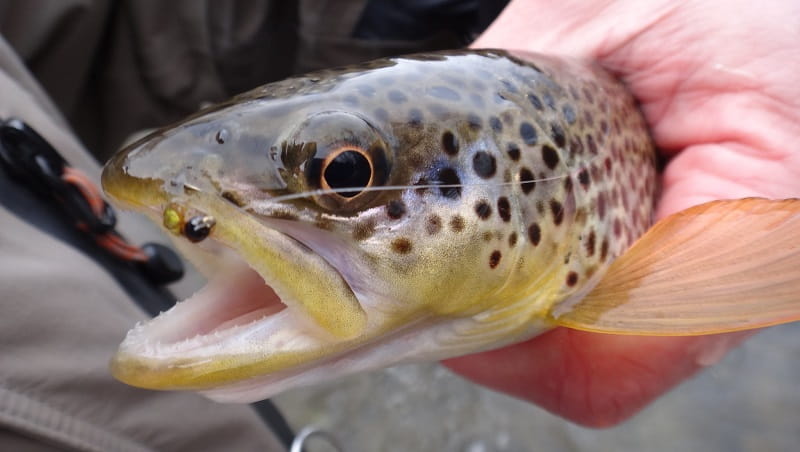
Going with smaller baits is often a better choice than using bigger baits unless the water is dirty or off-colored or is fast. Even big fish will eat a well-presented small bait.
Most trout’s food source is small. Small insects, single eggs, small baitfish.
Three-inch worms will almost always work as well or better than an 8-inch dew worm, even on large trout.
It’s also important to use baits that look natural and are already part of the trout’s diet. This can greatly improve your chances of catching more trout.
The Best Baits For Float Fishing
- Nymphs – Line nymphs like Hellgramites or Stoneflies are great. Artificial nymph flies that sink catch 90% of my largest trout when fishing rivers. – See Best Flies For Trout.
- Worms – Both live and plastic worms. Worms seem to work year-round, but they excel in the spring. – See Fishing With Worms.
- Eggs – This includes spawn sacs, or single salmon eggs. Eggs are a good option in spring and fall. – Tactics For Fishing Spawn.
- Beads – Egg imitation beads can be very effective, but only in rivers with medium currents – See Fishing With Beads.
- Minnow, leeches, crayfish – When fishing still water, live bait works best.
You should learn to rotate your baits to determine what the trout wants that day or throughout the day. I’ve seen trout crush worms all morning, but by noon and under high sun, the trout are only interested in small flies.
I list my top five baits on my page Best Trout Bait – The Only 5 Baits You Will Ever Need
6. Use The Right Gear To Float Fish For Trout

Mainline For Float Fishing
The mainline is the line that is on the actual reel. I mostly use Raven Monofilament because it floats, it comes off the reel easily, and it has been proven effective by thousands of river anglers. Braided lines in 14 to 20 pounds are also good.
I never use fluorocarbon as the mainline because it sinks, and that makes line mending (line above the float), and hooks set tough to do.
Monofilament fishing line in 4-pound or 6-pound is ideal for most trout streams. When fishing larger trout streams or when also using lures, an 8-pound line might be better.
- 6lb Raven Mainline
- 6lb Sufix Elite Premium Monofilament Line
- 6lb Sunline Line Fine Float ll
Best Spinning Reels To Float Fish For Trout
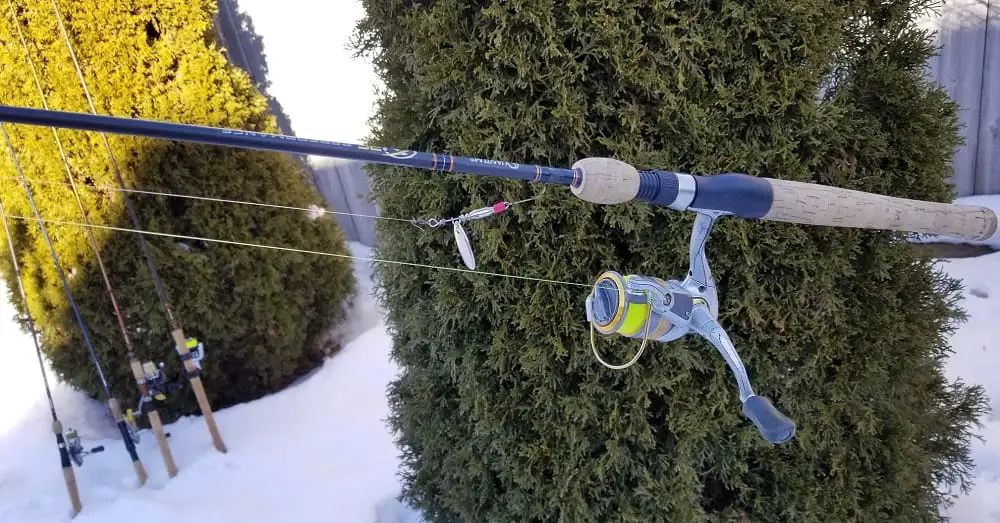
When it comes to spinning reels, get one that is proven to work well for float fishing. You want one that lets the line come off the reel smoothly so your float drifts naturally without getting hung up and giving a jerky presentation.
The three things to consider when looking for a good float reel for trout:
- A smooth Drag.
- A smooth spool lip so the line comes off easier.
- The right size.
You want a spinning reel that matches the smaller trout streams. I like a size 15 to size 20 reel. (1500 to 2000 for some brands).
If you want full details on the best reels for trout, go to my page 4 Best Spinning Reels For Float Fishing.
Spinning Rods For Trout Float Fishing
When float fishing trout rivers, you want to use a lightweight rod with a sensitive tip and one with good flex in the midsection. I prefer longer rods of 9 to 11 feet when float fishing.
The long rod allows you to keep the main line up and off the water longer for a better drift, and the longer rod is a good shock absorber that protects light leaders on the hookset and when fighting the fish.
One of my favorites is the 8-foot ultra-light Okuma Guide Select Pro Trout Spinning Rod. I use this rod with clients.
These are the best float fishing rods for trout: Prices may change
- Best Under $110.00 – 8 foot Okuma Guide Select Pro Trout Spinning Rod – Approx. $104.99
- Guides Choice – 8’6″ Light St. Croix Premier Spinning Rod – Approx. $199.99
- Best Economy Rod – 8′ Ultra-light Berkley Lightning Spinning Rod
- Best Big River Rod – 10’6″ light or 12’6 Ultralight Fenwick HMX Steelhead Spinning Rod.
See these rods and more – Best River Fishing Rods
7. Use The Right Floats For Trout Fishing
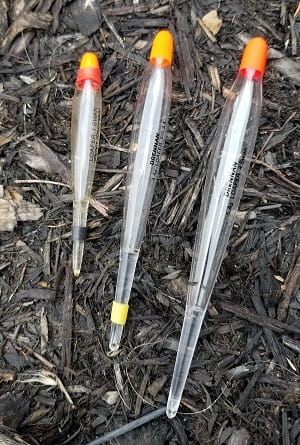
One of the best floats for trout fishing that I have tested and use is the Drennan Crystal Loafer Float.
If you use the wrong floats, you limit your success on the river.
Drennan floats are the best clear floats and are used by many trout and steelhead anglers. Since they are clear and thin, they are less intrusive and won’t spook wary trout.
They are also very sensitive floats for subtle bites, and they come in a variety of sizes. They are my go-to float when trout fishing and guiding for trout.
I mostly use the size #2 and 3 floats for trout fishing on most normal trout sizes rivers, but for bigger rivers, I will go up to the #4 and #5. Get Drennan Loafer floats at www.FishUSA.com.
Don’t forget to get yourself the Drennan float caps to secure these floats to the line.
I also really like Raven FM floats, especially on large trout rivers.
For more information on the best floats and why and how to improve their use, check out my page, 5 Best Floats For 2021
8. Best Leader For Your Trout Float Fishing Setup
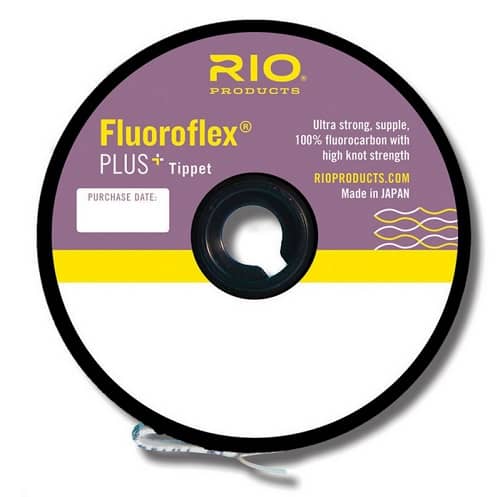
Trout are line-shy most of the time, and good leaders will catch more trout, so use a good three or four-pound fluorocarbon leader as a general-purpose trout leader.
I like to use 3-pound and 4-pound Rio FluoroFlex + Tippet for most of my trout fishing.
I will use different leader sizes in different types of situations to make sure I am being as effective as possible. That’s why you should read What Pound Test Leader For Trout and see what I recommend.
9. Best Weight For Float Leader Setup For Trout
Always use the right type of split shots.
- Black, grey, or neutral colors – DO NOT use shiny split shots
- Round Shots are Best – Do not use the ones with the removable wings. These can twist and cause problems.
- Soft Shots Are Best – soft shots do not damage light leaders.
I use the same split shots for float fishing as I do when fly fishing and when using bottom bouncing methods. See Best Weights For River Fishing.
Best Hooks For Trout
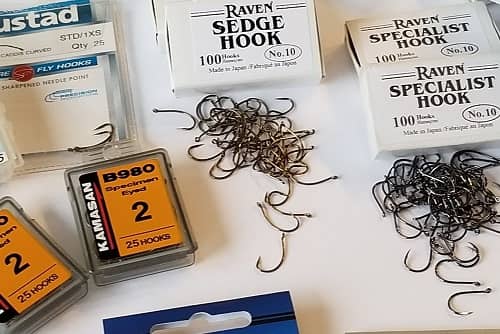
Hooks are one of the most important pieces of equipment, and they can make a big difference in hooking fish or not.
You want a hook that is the right size and the right shape for the fish and the bait that you are using.
Good hooks have a better hooking and holding percentage which is why knowledgeable trout guides are picky with the hooks they use. For most trout fishing, I use Raven Specimen hooks.
You will also catch more trout if you know how to properly put the bait on the hook, which I discuss on my page, Best Hooks For Trout.
How To Catch More Trout When Float Fishing?
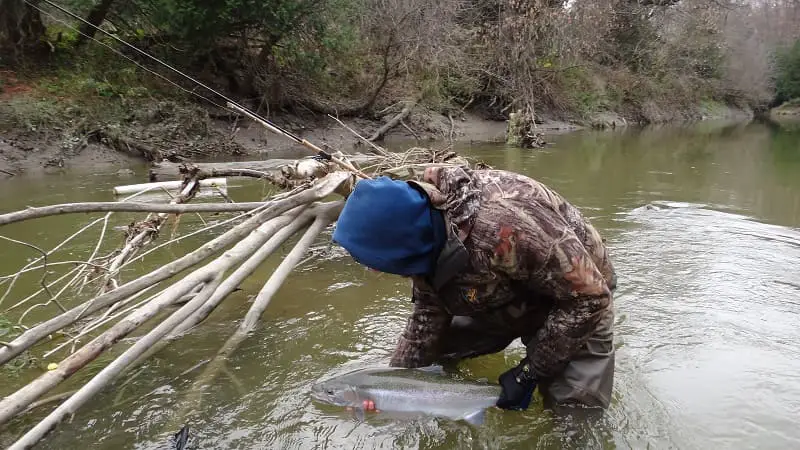
The right gear, combined with covering the water well, combined with finding the bottom, combined with using the right bait, and then topping it all off with speed control equals a lot more trout.
If any of these are not done well, you will struggle to consistently catch trout. This is true when using a float for trout, steelhead, or salmon on any river.
Rivers Suitable To Float Fish For Trout
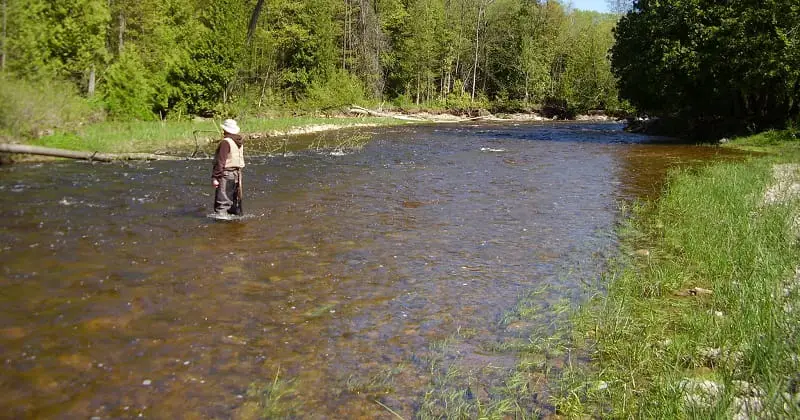
I have float-fished rivers that were over 300 feet wide and in creeks so small I could jump across them. Basically, any river can be fished with a float, but there are spots within the river where you should NOT float fish, and these areas are where other methods will work better.
In the above image, my client is fishing the deeper darker water, which is great for float fishing, but the water behind him is too shallow to float fishing well.
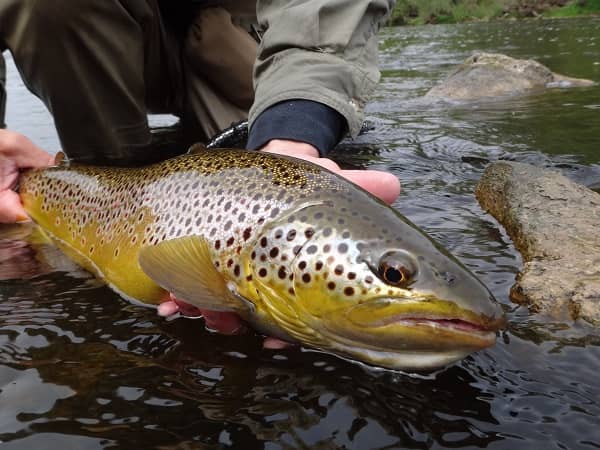
In water under 2.5 feet deep and spots less than five feet long, it’s much more effective to use my advanced bottom bouncing method, which you can see at Bottom Bouncing – 5 Proven Guide Tips For More Fish.
This article is the revised and shortened article. For the full article, click HERE.
If you have a question, comment, or advice about float fishing for trout, let me know in the comments below.
Tight Lines,
Graham
Resources:
- WVU – Effect of Diet, Age, and Genetics on Rainbow T ect of Diet, Age, and Genetics on Rainbow Trout Growth
- Science Direct – Nutrition requirements of rainbow trout
- FAO – Rainbow trout – Natural food and feeding habits
- Libre Texts.org – Stream Flow Dynamics – Channel Geometry and Flow Characteristics

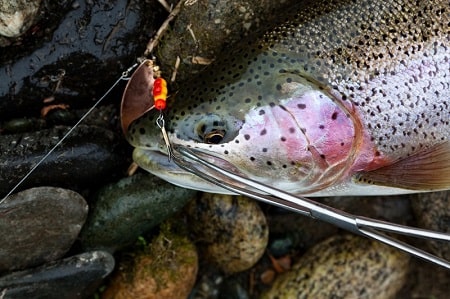
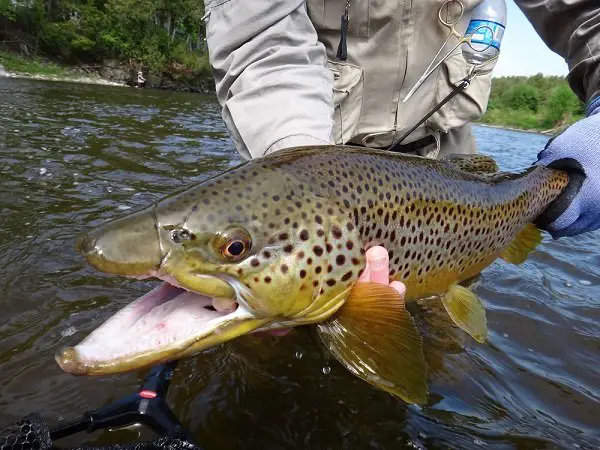
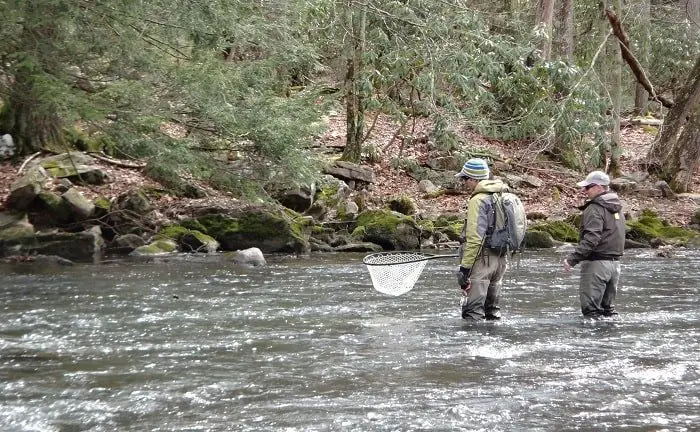
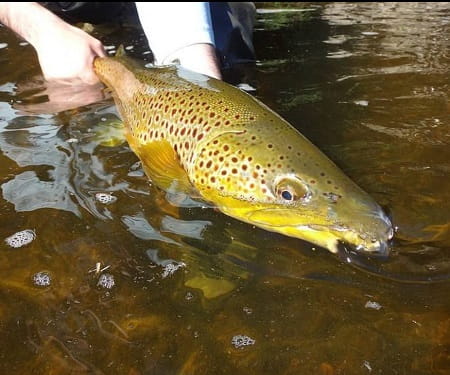
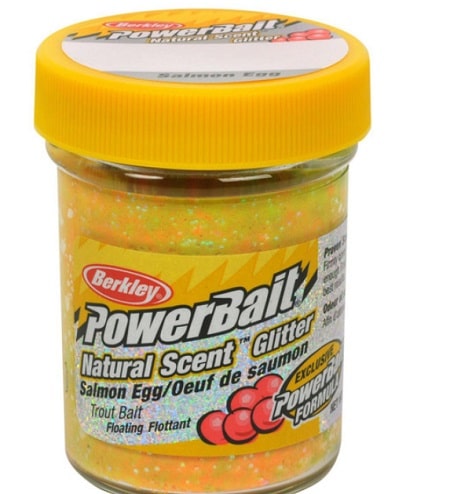
Graham,
I am just getting back to fishing after many years, I have found your articles extremely educational. the one thing I have not found and was curious about is the shot line. I have looked at the images provided, but struggle to determine the the spacing. Do you have a specific spacing? From the image I can tell there is 1 at each swivel, and from the articles, depending on the float used varying amounts of AA or AB shot. I assume more to the top swivel, with the remaining shot spread out along the 2nd 3rd of the line. An example for a 6.4g float might be 2x shot at the top swivel, 1 ~3″ down, 1 ~4″ from the last, 1 at the bottom of the top 2/3rds of the shot line, and the last just above the second swivel. I hope that makes sense. I know it doesn’t have to be perfect but getting ballpark spacing, I am sure, will only add to my successes.
Thanks for all the knowledge you have chosen to share, it really is invaluable.
Jay
Hi Jay,
You configuration will work. The key is more weight near the float, less weight near the bait. Spacing depend on if you use the same size split shots, in which cas i gradually increase disance the closer I get to the bait. However, some angler use different sized split shots evenly spaced, with the lager spit shots near the float, and the lightest splits shots near the bait.
There is a diagram of these two setups on my page 5 most effective float fishing leaders.
Good Luck.
Graham
Excellent information. Thanks.